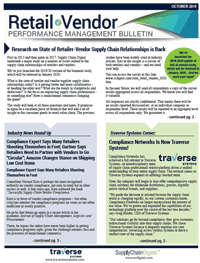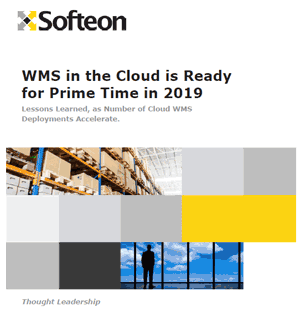"Order" Out of Fulfillment Chaos Part 2
A few weeks ago, I wrote a column on a very important but still relatively little known type of supply chain software called Distributed Order Management (DOM).
That column was in part based on a book I co-authored called "The Little Book of Distributed Order Management," which I am simultaneously proud and modestly embarrassed to say is my first book. As I said then, it's not the great American novel of my earlier dreams, but will make a nice stocking stuffer for the kids.
In great summary, in the first column I noted that DOM software was first developed and is by far best known for ecommerce fulfillment applications. It is now expanding its reach well beyond retailing and into other industries.
| GILMORE SAYS: |
I continue to find that today few supply chain pros well understand DOM, so I hope this has been useful.
WHAT DO YOU SAY?
Send us your
Feedback here
|
Distributed order management is related to, but generally different from, traditional Order Management Systems (OMS), which at least historically primarily focused on order processing and addressing all the items need to successfully complete that task, including pricing, promotions, credit checks, and credit card processing, to name just a few. They were not able to handle the order management needs of the new ecommerce companies. And so Distributed Order Management software was born.
DOM systems are order-fulfillment centric. DOM looks at how to source an order in a way that meets customer service commitments at the lowest total cost or in a way that fulfills some other objective of the company, while considering network work capacities and constraints.
With that brief recap, while the rise of omnichannel commerce has pushed DOM into prominence, there are actually a number of different use cases for DOM in supply chain. Here are what I consider to be the top five current use cases for DOM.
1. Enable and optimize omnichannel retailing: Omnichannel retail has been the catalyst for DOM interest and deployment, and it continues to be the area that sees the greatest number of implementations. This is true both for retailers, as well as, consumer goods companies and wholesalers selling consumer direct.
eCommerce requires a number of new processes, such as buy-on-line, pick up in store; store fulfillment; vendor drop ship, etc. Given this situation, retailers and consumer goods companies have two high level options: they can spend a lot of time and cost to modify existing systems, or they can deploy DOM to provide these capabilities with integration to, but little to no modification, of existing systems. Many are going to the external DOM approach.
2. Optimize order sourcing: Enabling omnichannel processes is only part of the answer. Most retailers and vendors are struggling to make profits in ecommerce. They are also looking for new sources of revenue, and of course to delight online customers in this Amazon-driven world. This is where the order-fulfillment optimization capabilities of DOM come into play.
When an order is received, from whatever channel, the DOM will use its rule engine logic to identify where to source that order from in a way that results in the lowest total cost while also meeting customer commitments and considering network or node constraints.
DOM systems make it possible for companies to be more flexible about fulfilling orders from a wide variety of fulfillment points. The result is not only lower fulfillment costs - in many cases, companies see a bump in revenue as well, as items that are ordered online but are not in stock at a DC can now be fulfilled from store inventories.
DOM also allows companies to set all kinds of complex business rules around order fulfillment. For example, companies can set a minimum in-store inventory level and a maximum number of online orders that a store can process over a period of time, so that online order fulfillment does not disrupt store operations. DOM can also be used to support vendor drop shipping.
Retailers and consumer goods companies aren't the only types of companies that can benefit from the ability of DOM to apply rules to optimally source orders. Any company with some network complexity and constraints relevant to fulfillment is a potential DOM candidate.
For example, one major company providing pharmacy services uses DOM to automatically route orders to one of more than a dozen potential distribution facilities based on a variety of attributes, including fixed capacities at each facility for processing certain types of orders.
A major industrial company faces a similar challenge in determining where to route orders across its direct customers and its distributor network if it is out of stock on an item. It is currently using DOM in a proof-of-concept stage.
3. Create enterprise order hubs: Many companies have a mishmash of different traditional order management systems, often acquired as a result of mergers and acquisitions over many years. The systems can be OMS's from multiple enterprise resource planning (ERP) vendors, different versions of order management systems from the same ERP vendor, and/or legacy systems.
In the past, a number of companies sought to address this scenario by trying to get all of their units and operations to use a single ERP system. But that is a long and expensive journey, and one that is often never completed due to the effort required and more mergers, divestitures, and acquisitions getting in the way.
 Increasingly, DOM is the answer instead. Rather than trying to get the whole company on a single OMS, the decision is made to implement DOM on top of all these myriad systems to provide a single repository for all orders. The DOM system can route those orders to the appropriate OMS and provide visibility and rules-based decision making. Increasingly, DOM is the answer instead. Rather than trying to get the whole company on a single OMS, the decision is made to implement DOM on top of all these myriad systems to provide a single repository for all orders. The DOM system can route those orders to the appropriate OMS and provide visibility and rules-based decision making.
This type of DOM deployment is often referred to as an "order hub."
4. Optimize inbound inventory: DOM is often generally viewed as a solution for fulfillment challenges, meaning outbound customer orders. But a small number of providers are also using DOM to reverse that logic and optimize the flow of inbound goods across many nodes in a distribution network.
This application is especially powerful for goods coming from offshore into domestic ports. Using information from an advanced ship notice (ASN) and facilitated in many cases by a vendor web portal, the DOM determines just before arrival where that merchandise should best be deployed. It makes that decision based on a number of variables, including on-hand inventory levels at each node, in-transit inventory, forecasts, upcoming promotions, and more.
The received goods are then cross docked at the import DC and shipped to the optimal node, whether that be a company's own DCs, third-party fulfillment center, or direct to store.
5. Manage multi-echelon orders and returns: Many large companies operate multi-echelon networks, with inventory in master DCs, regional DCs, local warehouses, and - in the repair and maintenance sector especially- a service technician's truck or van.
While companies in several sectors have multi-echelon distribution networks, we will focus on the service parts supply chain. The principles for that industry sector, however, should also be relevant for those in others.
DOM can help these types of companies answer what may seem to be a basic sourcing question: When a technician needs a part, from where in the network should it be allocated and shipped? This is a more difficult question than it might seem at first, as a number of factors need to be considered, including: current on-hand inventory by node, in-transit inventory, shipping costs, customer service commitments, customer expectations/urgency, and other factors.
There is also a second dimension to this DOM use case, which involves the reverse logistics process. More specifically, what happens when a technician has a part that needs to be returned because it wasn't needed, is damaged, or some other reason? Where should that part be sent within or outside of the company's network? That of course depends on many variables, including on-hand inventory at each node, forecasts, existing orders' shipping costs, and more. DOM can apply the same basic logic that it uses to makes decisions about where to optimally source inventory to also determine what location a product should be returned to.
So that's my view. I will note DOM and traditional order management are clearly starting to blend together, so maybe DOM as a distinct application goes away at some point. But I continue to find that today few supply chain pros well understand DOM, so I hope this has been useful.
What do you know or think of DOM technology? Let us know your thoughts at the Feedback section below
|
















